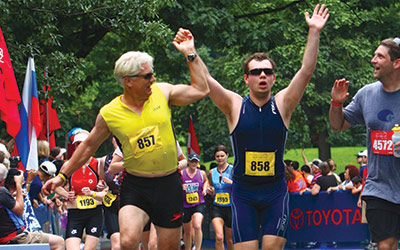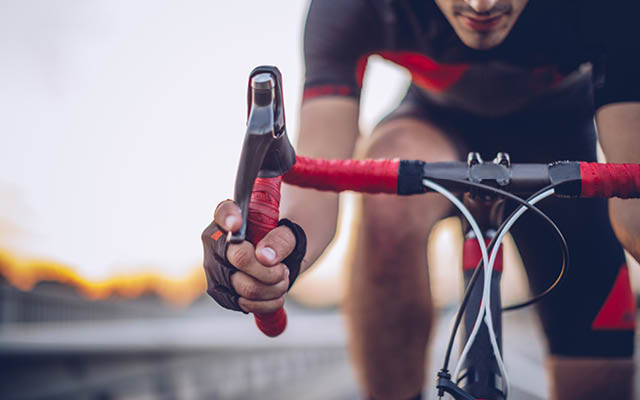“Tri (Harder)” is a series of posts by Kaelyn Riley, editorial coordinator and executive assistant to the founding editor for Experience Life. This series will document Kaelyn’s first-time experience training for the Life Time Triathlon.
I recently registered for the Life Time Triathlon — almost five years to the day after I took a spectacular fall down a flight of outdoor stairs and broke my right ankle in three places. It was only a fleeting moment, the split second it took me to choose a pair of flimsy flip-flops to wear outside in the rain. That split-second slip took two surgeries to fix, two weeks of bed rest, two months in a hard cast, and another six weeks strapped into a surgical boot.
All told, it was more than three months after my initial surgery before I put weight on my foot again. I was in physical therapy for untold months after we removed my hard cast, practicing my balance, working on my range of motion, and slowly building up the muscle tissue I’d lost in the interim.
The day my physical therapist finally cleared me to work out, I cried tears of relief. It was such a small thing — five slow, triumphant minutes on the elliptical machine — but I was just so grateful to be able to move again.
Coming On (Too) Strong
A few weeks after that first workout, emboldened by recent success at the gym and anxious for my body to finally begin working the way it used to, I was already moving too fast.
Midway through one morning cardio session, I felt a small but discernible pop in the top of my foot. I limped across the gym to my physical therapist’s office where he confirmed: I’d ripped a handful of tendons in my foot, newly knit and tender from my first injury. It was back to the boot for me.
It can be a struggle, really, to live in a body. I’d been still for such a long time after my surgeries, the whole experience characterized by moments of reckoning with what I wasn’t able to do. This final setback only meant a week or two of rest — hardly a major regress in the grand scheme of my recovery. But I remember vividly how frustrated I felt unearthing my surgical boot from the back of my closet, thinking my body had betrayed me, having to hobble around again like a broken thing.
[callout] I remember vividly how frustrated I felt unearthing my surgical boot from the back of my closet, thinking my body had betrayed me, having to hobble around again like a broken thing. [/callout]I’ve made a lot of positive changes in my life over these last five years, starting that day in physical therapy with a renewed sense of gratitude for my working body. In retrospect, I see that day I slipped on the stairs as the catalyst that sparked my own healthy journey, without which I doubt I’d have come to work for Experience Life magazine.
In some ways, though, as much as I feel I’ve grown, I’ve still had to return in these last weeks to that old lesson, which my physical therapist made clear to me that day in the gym as he wrapped my weary ankle: My body is not, in fact, a machine.
Learning Patience
It started innocently enough. I came home on a recent Wednesday after work feeling good, strong, and focused. I’d managed a solid run on the treadmill on Monday, a little quality time with the stationary bike on Tuesday. I’d even started mentioning my training program out loud to a few people — coworkers, my landlord (a triathlete himself several dozen times over), my partner, my mother. Each time, I’d felt the need to bury the lead a bit, prefacing my news with an undercut of sorts: I’m doing this thing. It might sound crazy. Please don’t laugh.
That Wednesday was supposed to be my rest day, but it was one of the first sunny afternoons in Minneapolis after a long, gray winter. Who wants to rest on a day like that? I’ll just take a short run, I thought to myself, just around the park and back. I pulled up a free run-tracking app on my phone, laced up my new super-supportive sneakers, and hit the pavement.
I’d only gone about two miles before I started to feel the aching in my joints. I stopped to cool down right away, but it was too late. I’d done too much, too fast, and while I’d put in some work on the treadmill before this, my body simply wasn’t ready for my first outdoor run on the asphalt.
Like that time years ago, I’d had a few modest successes and then, hastily, I’d thrown all caution to the wind.
And so, this week, I’ve been taking it slowly. I’ve been foam-rolling my aching muscles, doing some gentle lunch-time yoga, going for walks. Admittedly, this new slowness is partly out of necessity — that ankle won’t abide any running right now — and partly to make more space for remembering gratitude.
[callout] To have a movable, workable body is an incredible privilege, even when it’s a struggle. [/callout]To have a movable, workable body is an incredible privilege, even when it’s a struggle. I’m lucky to have been able to jump into my training so enthusiastically, and luckier still that my body has reminded me, gently, to be a little more patient. In July, I hope to take that lesson with me to the finish line.
Sports Injuries: The Mental Game
Recovering from a sports injury requires more than just physical therapy; there’s also psychological healing. Sports psychologist Alan Goldberg, EdD, offers some strategies for dealing with an injury.
- Go ahead and be sad — at least at first. It’s important to mourn this loss, just like any other. There’s no need to be macho.
- Then, maintain a positive attitude. Once you shake off your feelings of sadness and loss, an optimistic outlook will speed the healing process while decreasing the emotional pain. Goldberg encourages his patients to repeat the mantra, “If it is to be, it is up to me.”
- Focus on “what is.” “Don’t play the ‘coulda, mighta game,’” says Goldberg. You’re injured. Accept it and move forward.
- Set new goals for yourself. They may be smaller at first, but that’s OK. The key is to make sure they’re achievable, and build up from there.
- Take an active part in your healing. Don’t cut corners. Don’t resist or resent your physical therapy. No one’s making you do this. The only person who loses when you loaf is you.
- Continue to practice and work out. Even if you’re temporarily sidelined, you can visualize playing your sport. Goldberg calls this “improving your headset.” A huge part of sports is mental, after all.
Seek out the support of your teammates. You’ll be tempted to isolate yourself. Don’t do it. Show up to that rec-league hoops game just for the camaraderie. Meet your running or biking group when they grab coffee or a beer at the end of their workout. The connection and inspiration are important.
Excerpt from “Learning From Injury.” Find more strategies for healing in “Give It a Rest” and “Facing Down an Injury.”




This Post Has 0 Comments